Has it ever happened to you to read an SEO article and, on the verge of your maximum concentration, to stumble upon a term you don’t quite know what it means?
Be it slang, jargon or an expression used with a different meaning than we might have thought, at some point everyone has been in the position of browsing several web pages just to understand what that term actually referred to.
So, we created an “ SEO Lingo”, maybe the most comprehensive and user-friendly glossary of SEO terms.
Now you don’t have to go from page to page in order to find the idiom you are looking for. We put them all together in a nice, organized list so you can easily access it any time you need it.
Alphabetic Navigation (or hit CTRL+F to quickly search for a word)
# A B C D E F G H I J K L M N O P R S T U V W
As this kind of work is a perpetual process, we would be more than grateful if you could suggest new terms to add to our list.
Share any “Undocumented” Term here (and we will add it to the list)
.htaccess
The .htaccess is a configuration file for Apache Web Servers. You can use it to enable and disable different Apache functionalities. It is commonly used for redirecting pages, but can also be used for many other things. And yes. It does start with a period. The file itself has no name. So basically… it’s just an extension.
200, 301, 302, 400, 404, 410, 500
Above the fold
This term refers to the first section of a website, the one that is visible without using the scroll wheel on your mouse. It was used in newspapers, too. The section usually holds the most important pieces of news, and the most expensive ads. Google recommends that you prioritize the loading of above the fold content. The section under it is called below the fold.
Ahref
The <a> tag defines a hyperlink. It’s basically a link that points to another location, internal or external. The location it points to is indicated by the attribute href. An ‘a href’ is then Hypertext REFerence. Between the opening tag <a> and the closing tag </a> we have our anchor text. This is where the tool Ahrefs draw it’s name from.
ALT tag
ALT text is an alternative text associated with an image, used by web browser agents that cannot display graphics. Basically, alt text ensures that your web page is visible and accessible and no functionality is lost, even if the viewer has turned off images or uses a screen reader. The Alt attribute is a description of an image in your site’s HTML. For instance, people with impaired vision can still interact with that image due to this feature.
Alexa
Alexa is a subsidiary company of Amazon that provides traffic rankings based on the analysis of people who access the sites while using the Alexa toolbar. The accuracy of this data may be questioned due to the fact that the analysis is made only on the internet visitors that use the Alexa toolbar.
Algorithm
Heaven’s gates are closed. Google changed the algorithm!
Tweet
Most likely referring to Google, the Google algorithm is the system that determines what sites rank for particular keywords. If you want to get a general idea as to what Google algorithms look for, you can refer to Google’s own How Search Works page.

Anchor Text
API
API stands short for Application Program Interface. This interface specifies how different components of a software interact with each other.
API Key
An API Key is a unique value assigned to a user of that particular service. It acts as an identifier to let the software know if access should or should not be granted to the tool.
Article Marketing
Article Marketing is a link building strategy where you submit short pieces of content to article networks like EzineArticles, HubPages, Squidoo and similar networks in order to gain backlink in the article itself or author bio. Many article networks were penalized when Google created an algorithm to judge the quality of content on a website. Some have recovered while others have not, making article marketing links lower quality.
Authority Links
Authority links are simply backlinks from a highly trusted website. Authority links would be those from major news networks (CNN, BBC, etc.), brands (Apple, Amazon, etc.), or any other authority site on the internet.
Authority Site
An authority site is a site that covers a specific topic to the very core of its depths. In theory, a site becomes an authority once it reaches 100.000 words. Let’s say that you randomly pop up into a site called www.cognitiveseo.com when searching for something, but you realize you can find anything about SEO on it. That’s an authority site.
Backlink
Backlink Analysis
Backlink Analysis is the process where you review the links to your website and to your competitors’ websites to determine the strongest links, weakest links, link types, link categories, and links you should go after next.
Backlink Checker
Backlink checker – is a tool that determines how many backlinks are pointing to your website. It is important to keep track of the backlink numbers as they influence your search engine ranking overall.
Black Hat
Black Hat SEO refers to aggressive search engine optimization that violates Google’s Webmaster Guidelines.

Blacklist
A blacklist is a database of queries that are blocked by a specific service. There are blacklists for e-mails, websites, or IPs. The most popular blacklists include IPs, as they can block entire servers (both websites and e-mails). Servers and search engines use these blacklists to protect their users from spam and malicious intent. You can check if your IP is blacklisted here.
Blog/Blogger/Blogging
A blog is short for weblog. It’s a log… on the web. You post articles on it and they are usually listed in a chronological order. Most websites now have a blog. They post useful and interesting things related to their niche in order to attract traffic. A blogger is a person that owns a blog and writes on it. There’s a difference between someone who writes on blogs and a blogger. A blogger has a following and something to say. A blogger could earn his living off blogging.
Blog Comment Spamming
Comment spamming is a blackhat SEO technique in which a user constantly comments on other websites in order to get a backlink to his own. It can be manual commenting or automated commenting through software such as ScrapeBox or GSA Search Engine Ranker. Blog commenting isn’t a bad thing, as long as it’s relevant and not done excessively.
Broken Link
A broken link is a hyperlink that returns an error code such as 404, which means it doesn’t exist or can’t be found on the server. It’s usually a result of misspelling the URL. A broken link can come in the form of internal links or backlinks.
Broken Link Building
Broken Link Building is a link-building tactic in which you can contact a webmaster who has a broken link and recommend him/her various alternatives that can include the target site. This is considered to be a successful white hat technique of link building strategy with relevant results in markets with thick content and a dynamic community. Yet, it didn’t generate good outcome for links relating to pure sales pages. This tactic should be advantageous for yourself but also for the web, as you replace lost or abandoned content with quality content.
Bounce Rate
Bounce rate represents the percentage of visits in which people leave your site from the entrance, without interacting with other pages. The bounce rate can measure the effectiveness of a site. A high bounce rate can be due to the content of your site but also due to usability issues or because the “netizens” found the information they needed on the first page.
Bread Crumbs
Bread crumbs refers to links that are usually above the main content. They have two main functions: to allow the user to easily navigate on your site and also search engines to easily determine the structure of your site. An example of how breadcrumbs usually look like is this: Home >On line books >Gone with the wind > Chapter 2
Cache/Web Cache
A cache is a hardware or software component used to store data so it can be served faster. On the internet, a web cache stores the content of your website so it can be served faster to the user. That’s why, sometimes, it seems like the page hasn’t been updated. The cache has not been refreshed. There are more types of cache. The most popular is a Broswer Cache. It stores data, such as images, in a temporary folder on your computer storage. This way, they won’t have to be downloaded once you access the website again. Other types of caches include server cache and router cache.
Call-to-action
A call-to-action is a message that suggests to an user that an action should be taken. It can appear under many forms, such as text links, buttons or images. A call to action can suggest actions such as purchasing a product, clicking on a link or liking something, etc. Call-to-actions can be verbal as well, if you’re recording a video or podcast
Canonical Tag/Canonicalization
Yes, canonicalization can also make you a champion at Hangman.
Tweet
Choosing a preferred URL for your website. For example, you may want to choose http://www.domain.com as your preferred domain and set your web server to redirect traffic from http://domain.com, http://domain.com/index.php, and other variations to http://www.domain.com. You can read more about this in the help section for Google Webmaster Tools.
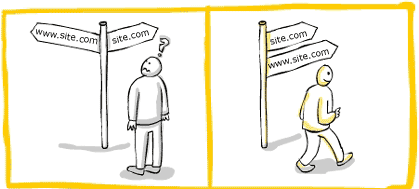
Content Delivery Network (CDN)
A content delivery network stores your content under cache format in a series of servers. These data centers are placed in different points around the globe. This way, users can access your sever faster. For example, if your main server is in the US, it will be fast for the US, but slower for somenoe in Europe. If your CDN has a datacenter in Europe, the user will access that one instead.
Click Fraud
Repetitively clicking on your own Internet Ad can lead to severe injuries.
Tweet
Click fraud is an illegal practice that occurs when individuals, automated software or online bots are clicking on a pay per click advertising link with the purpose of generating a charge per click. Click fraud has generated a lot of controversy. Research on this matter shows that persons that make most use of click fraud are individuals who aim to increase their own ad banners incomes and companies who want to impair the competitors’ budget.

Cloaking
Cloaking is a form of doorway page technique in which the content presented to the web crawler is different from the content delivered to the user’s browser. Cloaking is considered to be a violation of Google’s Guidelines as the user receives different content than he expected. Cloaking is often considered to be a black hat SEO technique because it tries to trick and manipulate the search engine index.
Code Swapping
Code swapping is similar to cloaking and aims at changing the content in a site after high ranking has been achieved for that site. Basically, the optimised page is switched with another, different from the original one in terms of content. Yet, on a re-index, the content that has been changed will be detected and another ranking algorithm will be applied. The use of this technique might lead to Google penalization.
Compression
Content Scraping
Content Scraping is the blackhat SEO process of mass collecting content from the web and posting it on a website. The webmasters that use these techniques try to get their content indexed first, so that the other site looks like the duplicate.
Content Spam
Content Spam is a type of content generated with the purpose of manipulating search engine ranking.
Contextual Advertising
Contextual advertising is a type of targeted advertising, relevant to the content, where ads are selected by automated systems and customized for each user. For example, if a user is visiting a site with online movies and that site uses contextual advertising, the user might be exposed to ads such as cinema tickets or DVD sellers. Being linked to the context, this type of advertising is more likely to be clicked and thereby, is likely to be a generator of generous income.
Conversion Rate
Shortly, conversion rate refers to the number of potential online visitors that become “buyers” on a web site. “Buyers” can mean actually buying a product, filling out a form or subscribing to something on a site, depending on the web page’s goal. For example, if there are 100 visitors on a site that sells books and 5 of those visitors actually buy books from that site, then the conversion rate is 5%. The larger the conversion rate is, the more successful that site will be, usually.
Contextual Link
A contextual link is a hyperlink that appears under an anchor text and is surrounded by relevant content. Contextual links are usually the best type of links that you can get for SEO.
CMS (Content Management System)
A content management system is a software for creating and managing web content. Some of the most popular CMS out there are WordPress, Joomla and Drupal. They are usually user friendly and a lot easier to implement than creating a website from scratch.
Cookie
A cookie is a small file used to store specific information, such as browsing activity, or affiliate links. It can affect search results. For example, if you visit a site more often, that site might rank higher, only for you. To accurately check rankings, use Incognito mode or private windows in your browsers. These windows ignore cookies.
Copyright
Copyright is the legal right that grants the creator of an original work exclusive rights to use it and distribute it. It applies to any type of content, be it visual, audio, or text.
Copyright Infringement
The unauthorized use of copyrighted material is known as copyright infringement. Be careful what content you take from the web, as it might result in legal consequences. A common issue is the use of images on Google. While they may seem free, they’re actually not! If you want images that are royalty free, go to Tools -> Usage Rights when searching on Google Images.
CPA
Cost per acquisition (or cost per action) refers to the price that a publisher pays to an advertiser for each unique user action the advertiser provides.
CPC
CPC is an abbreviation for Cost per Click and refers to the actual price you pay for each click in your pay per click campaign (PPC). CPC is important because it represents a form of interaction between a visitor and a company’s product and also determines the financial success of the paid campaigns.
CPM
The dilemma with “M” from “CPM” is solved. In the Roman numerals, M stands for 1000.
Tweet
CPM is an acronym for Cost per Thousand. If you’re wondering where the “M” from “CPM” comes from, you should know that in the Roman numerals M represents 1000. It is also referred as “cost per thousand impressions” and represents the cost paid by an advertiser for the display of 1000 (one thousand) impressions of a banner or other types of advertisement on a web page. CPM can also be a method to find out how profitable a website is or what potential it has of becoming one. For instance, Facebook is the leader of the market in CPM niche.
CSS (Cascading Style Sheets)
CSS (Cascading Style Sheets) represents a mechanism of adding style to Web documents. Its main characteristic is that it enables the separation between a document content and a document presentation in order to improve the accessibility and flexibility of a content. CSS include elements such as fonts, colors, layout or spacing. Another regular use of CSS is for adjusting the display differently, depending on the device or the screen size that is used by the viewer.
Crawler
A crawler is a program, also known as a “spider” or a “bot” that systematically browses web sites and reads their pages and their content with the purpose of web indexing. In the context of SEO, crawlers are important for the determination of a site’s importance and ranking in the results of web searches for a specific keyword. Crawlers are very active and can visit a website several times a day, checking for updates. Maybe the most famous crawler is Google’s crawler, known as Googlebot.
Funny fact: They are called spiders and crawlers because WWW means World Wide Web.
Crawl Budget
Crawl budget is the number of pages Googlebot crawls and indexed in a timeframe. Each site has a crawl budget. If a website has fewer URLs, most of the time, it will be crawled efficiently. On bigger sites, it is more important to prioritize what to crawl, when, and how many resources are allocated for crawling. Basically, if your number of pages exceeds the crawl budget, those pages won’t be indexed in Google.
Crawl Depth
The crawl depth is the extent to which a crawler indexes the pages on a website. When a crawler accesses you website, it keeps digging through the links. A page can have subpages and those subpages have subpages of their own and so on. It’s similar to how folders and subfolders work on your storage.
Citation
Citations are listings for your business that designate it as a local business. Popular citation sources for local search marketing include Google+ Local, Bing Local, Yahoo Local, Yelp, Merchant Circle, and other local directories.
Click Through Rate (CTR)
The number of times people click on a link in search results vs. the number of impressions (times seen) in search results.
Competitor Analysis
Competitor Analysis (SEO) is the process of researching your competitors in search to determine the best on-site and off-site search optimization strategies they use to rank high.
Dedicated Server
A dedicated server is a server exclusive to a single owner. Other known types are VPS (Virtual Private Servers) and Shared Hosting.
Deep Link
A deep link is a hyperlink that points to a sub-page of a website, instead of a homepage. The more slashes you can find in the URL, the deeper the link is.
Deep Link Ratio
The deep link ratio is the percentage of hyperlinks that point to other pages than your homepage. If you had 100 pages and 60 were pointing to pages other than your homepage, your deep link ratio would be 60%.
Domain Name
On the internet, a domain name is what you type in your browser to get to a website. It’s the website’s name. It can point to one or more IP addresses and it’s always accompanied by one or more suffixes known as extensions (.com, .net, .org, .co.uk, .com.au).
Domain Name Age
In SEO, the domain name age refers to when a website’s name was first registered. It is believed that domain age plays a role as a ranking factor. If we’re in 2017 and the site’s domain name was registered in 2010, the domain age would be 7 years.
Dwell Time
In digital marketing, dwell time represents the time a user spends on the same page of a website. Dwell time is believed to be a ranking factor.
Dynamic URL
Doorway Page
Doorway page concept is often used in the context of black hat SEO and refers to poor quality pages that are optimized for a particular keyword or phrase. The purpose of a doorway page is to mislead the search engines and gain high ranking for certain sites. Basically, doorway pages redirect the visitors to other web pages without their knowledge, using a form of cloaking. They are also known as portal pages, gateway pages, entry pages or jump pages.
Duplicate Content
Duplicate content represents a block of content that is similar or identical within several domains. Although it is not deceptive in origin, there are cases where content is duplicated with the purpose of manipulating search engine rankings. The main problem with duplicate content is that search engines don’t know which version is the original one and are forced to choose the version that is more likely to be the original. This usually leads to loss in terms of traffic and ranking for site owners and less relevant results for the search engines.
Dofollow/Nofollow
Dofollow / Nofollow – Nofollow is an attribute webmasters can use when linking to a website that tells search engines to essentially ignore the link. Social networks are notorious for using nofollow links when linking to external websites. Links without the nofollow attribute are referred to as dofollow.

Editorial Link
An editorial link is a backlink acquired naturally from the editor of a website. These links are not requested or sponsored and are the result of a good content strategy. Google likes editorial links, so it’s a good idea to have them.
Encrypted Search
Encrypted Search refers to the fact that Google encrypts searches that people do through a secure connection. In an encrypted search, the keyword data doesn’t pass through websites, thereby the users cannot be tracked. Also, a segmentation of the users by keywords within their analytics software cannot be done anymore. According to Google Webmaster Blog, “a web site accessed through organic search results on http://www.google.com (non-SSL) can see both that the user came from google.com and their search query. However, for organic search results on SSL search, a web site will only know that the user came from google.com”. One of the effect of encrypted search is the increased quantity of not provided.
Ethical SEO
Ethical SEO is a synonym of WhiteHat SEO. It’s the process of optimizing a site for search engines without the use of shady, black hat tactics. An Ethical SEO strategy would include good on page optimization, quality content and influencer outreach.
Exact Match Domains (EMD)
In SEO, EMD has nothing to do with Electro Motive Diesel .
Tweet
Exact Match Domains are domains that use a particular keyword or phrase instead of a branded name. For example, seotools.com would be an EMD whereas cognitiveSEO.com is a branded domain. EMDs ranked well for a long time, but in 2012, Google released an update that lowered many EMDs rankings in search. There are still lots of EMDs that rank well for their keywords today, mostly based on whether or not they have quality content.
Exit Page
An exit page is just what it sounds like. It’s the page through which a user exists your website. It’s a good idea to know which pages are exit pages so you can optimize them for user retention.
External Link
An external link is a link pointing from a website to another website other than itself. If your website links to someone else’s website, that’s an external link. If someone else’s website links to your website, that’s still an external link.
Fresh Content
Fresh content is a concept in SEO that refers to how often a site is updated with new information. It is believed that Google likes it when sites update their content on a regular basis. Updating more frequently might get search engines to crawl your website more often. Fresh content could be either completely new articles and pages, or simply new information added to old one. (this article, for example, has been updated once with fresh content).
FFA
FFA stands for “Free for all” and refers to websites that allow anyone to add a link pointing to their pages. FFA pages have no human intervention and usually they don’t weight much in search relevancy as they usually point to low quality website. For example, on an FFA page you can find a sport site listed between art museums and spatial engineering.
Frame
In the digital world, a frame is more than a fancy piece of a painting.
Tweet
A frame is a part of a webpage that displays content independently of its container. This means that the elements that are in a frame may or may not come from the same web site as the other content elements. As a result of that, in terms of SEO, although the data in the main body, the header and footer appear intact, they actually are different files that, when indexed by search engines, are broken into pieces. For instance, search engines may see your home page as empty and will not index the content of your website at all.
FTP (File Transfer Protocol)
You use the file transfer protocol to transfer files between your computer and server. You can create FTP accounts on your server. These accounts can then connect to your server using a user and a password. A popular FPT client is FileZilla.
Gateway page
Gateway page is the same as a doorway page.
Google Penalty
Google Penalty is considered when a website has broken Google Webmaster Guidelines, and Google penalizes it by lowering its rankings in search results for particular keywords or removing the website entirely from the index.
Google Panda
Google Panda is not a new type of Asian bear.
Tweet
Google Panda is the name of a series of Google algorithm updates that evaluate a website’s quality of content. Websites with low quality content and a high number of ads see a loss in search rankings when the algorithm is updated.
Google Penguin
Watch out, web spam! The penguin is coming for you!
Tweet
Google Penguin is the name of a series of Google algorithm updates that evaluate a website’s use of off-site (some on-site) optimizations. Websites that use techniques such as unnatural linking, keyword stuffing (trying to optimize for too many keywords on one page), low-quality link building, spam link building, etc. saw a loss in search rankings.

Google Bomb
The first known Google bomb returned Microsoft for the search “more evil than Satan himself”.
Tweet
Google bomb refers to the practice of making a group of keywords searched on diverse searching engines return a totally unexpected website. This can be made through the creation of numerous links to that websites’ page, including the searched keywords. This practice usually has humorous purposes but is also used to share a political or social ideology or to drive traffic to a business. The first known Google bomb was in 1999, when the returned site for the search “more evil than Satan himself” was Microsoft. Maybe the most famous Google bomb was “the miserable failure” from the year 2000. When searched on Google, this keyword would return George Bush’s biography site from the White House.
Google Bowling
Shortly, Google bowling means spamming in somebody’s else name. It’s usually brought into discussion related to negative SEO and refers to the practice of spam links to the competitor’s website with the purpose of causing them a Google penalty.
Google Dance
Google dance represents the period of time that major index updates were made by Google. As a result to this period, rankings of web sites may fluctuate even several times a day. In the Google dance, Google calculates the pagerank, and many other metrics, of each page and changes the SERP for all keywords.
Google Juice
Google juice is slang for a website’s value as determined by Google through Page Rank. The more juice a web page has, the higher it will be positioned in search results. Google determines the “juice” according to “who links to what”, mostly. If, for instance, a high-ranking page links to other pages, it will transfer relevancy for the pages it linked to and, implicitly, will give it more Google juice.
Googlebot
Googlebot/Google’s spider program refers to Google’s web crawler, also known as “Google spider”. Googlebot collects information from the web in order to permanently update the Google index. Google spider visits billions of webpages and detects new sites, changes to existing sites or dead links in order to keep the Google index up to date.
Google Disavow Tool
Disavow the links? Hmm..let’s be cautiously optimistic…
Tweet
Google Disavow Tool is a tool through which you can remove links that you believe to be unnatural, spammy or low-quality. It’s actually a tool that asks Google not to take into account certain links when it evaluates your site. The main problem is identifying correctly the links that negatively affect your site. Disavowing the wrong links might lead to a drop in ranking and also to a Google penalization. Identifying unnatural links may be a tough job. You may use tools like the automatic unnatural link detection tool in order to ease the process.
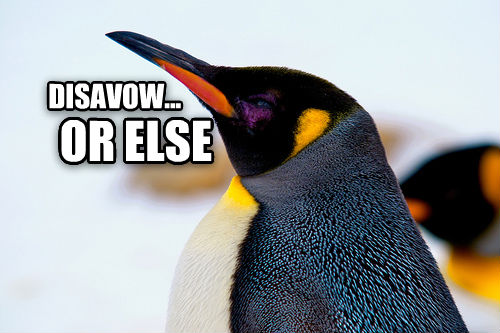
Google Analytics
Google Analytics is a service offered by Google that provides statistics and digital analytics about a web’s traffic, traffic sources, conversions rate, customer segmentation, sales, bounce rate, etc. It is a tool that can be useful for marketing professionals, content developers but also webmasters. The service is free of charge for sites that generate less than 10 millions hits per month.
Google Adwords
Google Adwords refers to Google’s online advertising program that allows your ad to appear on Google and its partner websites. According to the keywords you are interested in, Google Adwords helps you place your ad in relevant search results. The charging is made when a visitor clicks an ad, usually.
Google Adsense
Adsense is part of Adwords. Adsense is used by publishers (website owners) to earn money from displaying ads on their sites. Every time a visitor clicks on an Adsense ad on your website, the advertiser pays you some money.
Google Keyword Planner
Google Keyword Planner is a free, basic keyword research tool from Google Adwords. You use it to determine which keywords are best for your PPC advertising campaigns, but can also be used for SEO purposes. However, Google offers more information about the search volume to those who have active advertising campaigns.
Google Search Console (GSC)
In a few words, Google Search Console (former GWT or Google Webmaster Tools) is a free of charge web service that allows webmasters to check their indexing and to optimize their site’s visibility. CSV is designed to function as a communication mechanism between Google and site owners, helping webmasters to identify the main issues on their sites.
Google Sitelinks
The Google Sitelinks are the links that display under a website’s name in Google when a brand name search is performed. They are used to help users access the section they need faster. There is no clear way to get these links to show, but domain age, domain performance, structured data (schema markup) and a good internal linking strategy can help.

Google Universal Search
Google Universal Search is a type of search in which results from multiple specialized areas are displayed in the web search listing. For example, results from Google News, YouTube or Google Images will be listed in the main Google results web page.
Grey Hat SEO
Grey hat is basically a black hat who uses cheap laundry detergent.
Tweet
Grey Hat refers to SEO using both Black and White Hat techniques.

Guest Blogging
Guest Blogging is a strategy used for link-building and brand generation, where you submit content to other websites in order to gain a backlink within your author bio and/or generate interaction with the site’s readers. Guest blogging works best when you don’t think about it as link building but approach it as authority building instead. In 2014, Google announced possible penalties on Guest Blogging done for the sole purpose of influencing a site’s ranking in Google.
Headings (H1, H2, H3)
Headings are HTML tags that carry a significant weight in rankings. Usually, the H1 is very similar to the title tag, if not exactly the same. There should only be a single H1 tag on each page. It’s also a good idea to use heading hierarchy. For example, a H2 may contain three H3s, then you could have another H2 with another three H3s. The H3s could have some H4 childs, but you could also just bold that text.
Hidden Content
Hidden content is content that exists in the HTML version of the page, but isn’t directly visible in the browser. Although not always the case, it’s often used as a black hat SEO tactic, to add extra content that only the search engines will see.
Href and A Href
Href, short for Hyperlink Reference, is an attribute of the <a> anchor tag or what we know as a link. The href specifies the source where the anchor tag should point to. It can be internal (your own website) or external (another website), relative (/page/) or absolute (www.site.com/page). A full anchor tag with href also contains an anchor text and would look something like this: <a href=”http://site.com”>anchor text</a>.
Hreflang
Hreflang is an HTML meta tag attribute that specifies what language version of a site should be displayed in the search engines. The attribute must be reciprocal. For example, if you have both English and German versions of your website, the English version should have a hreflang=”de” attribute, and the German version should contain a hreflang=”en” attribute. More about this can be read here.
HTML (Hypertext Markup Language)
HTML is the most popular markup language for creating websites and web applications. HTML is often used in combination with JavaScript and CSS (Cascadig Style Sheets).
HTTP (Hypertext Transfer Protocol)
HTTP controls how hypertext is transfered around the web. It represents how components communicate with each other, and has a series of permissions and restrictions.
HTTPS
HTTPS is the same as HTTP, the only difference being that it usess SSL encryption to secure the transfered data.
HTTP Status Code
The HTTP response status code indicates whether a HTTP request has been successful or it has encountered some sort of problem. See status code examples here.
Hummingbird (Google Update)
Google Hummingbird is an update in the Google search algorithm that addresses synonyms and context. It was released in 2013 and its purpose is to identify the user’s search intent in order to return the most relevant search results.
Icognito Tabs/Private Windows in Browsers
In a Web Browser, an incognito tab (or private window) is a tab that does not store Cookie information. This means that previous searches or visited sites won’t affect your search results, although location might still influence them. You can access a private tab by pressing CTRL + Shift + N.
Image Optimization
There are two types of image optimization. The first one refers to the keywords used in the image’s URL, description and title. Although Google can recognize images, it can’t really tell what it’s about, so it uses the description to figure that out. A well optimized web page should include some keywords in its image descriptions. The second type refers to size. This is very important in SEO, as it directly affects a website’s loading speed. Slow loading websites get a lot less traffic than fast loading ones. Don’t use CSS to shrink a 500×500 pixels image to 200×200 pixels. Resize it and use the 200×200 version directly. Also, use image compression websites or plugins to make your images KB size as small as possible.
Impressions
Impressions refer to how many times your link/ad/website has been in the view field of a person, without being clicked. For example, if your site is ranked 3rd in Google and 1000 people view that Google web page, you would have 1000 impressions.
Inbound Link (Backlink))
Inbound Link (Backlink) refers to an incoming link to a website or a web page. A high number of inbound links is an indicator of the importance of that website. In SEO lingo, inbound links are also known as Backlinks, Incoming links, Inbound links, Inlinks or Inward links.
Internal Link
Indexed Pages
Indexed Pages refer to the website pages that have been visited, investigated and stored by a search engine. The purpose of indexing is to improve the relevancy in a search query. If a page has not been indexed by a search engine, that page will not be listed in the search engine results.
ISP (Internet Service Provider)
The ISP is the company which provides you the internet. If an ISP has a lot of spammy users, entire IP classes can get blacklisted. If your IP is also on that blacklist, sites might start blocking your computer from accessing them.
Javascript (JS)
Javascript is a programming language often used to create interactive effects in web browsers, such as animations in sliders. Although very powerful, it’s also very heavyweight. Sites with a lot of scripts tend to load slower.
John Mueller
Juhn Mueller is the current head of Google’s Webspam team. He hosts regular hangouts on the Google Webmasters channel. Webmasters from all around the world can ask questions about SEO and website performance there, and John will answer.
KPI
KPI stands for Key Performance Indicator and it’s a value used to measure how effectively a business is in achieving its main objectives. For example, in a web based business, traffic can be a KPI. You measure it to determine the success of your SEO and marketing efforts.
Keyword Density
Keyword density refers to the percentage of times a keyword or a keyword phrase is found in the content of a page, among all other content. For example, if on a 100-word webpage a keyword phrase is repeated 5 times, regardless if it’s in the content, headlines, captions, advertising, etc., the percentage of the key density will be 5%. There isn’t a rule or an optimum percentage of the keyword but you have to take into consideration that too little might not be clarifying enough for the search engine to figure out what the page is about and too much might have an unnatural aspect.
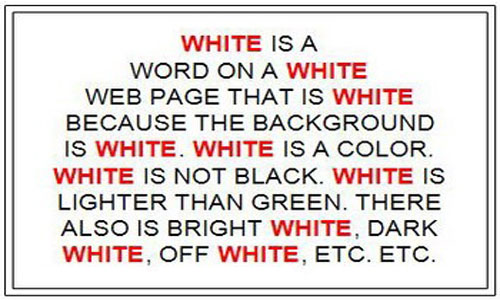
Keyword Research
Keyword Research is the process of determining the right keywords to target for your search marketing campaign.
Keyword Stuffing
Keyword stuffing is usually correlated to unethical SEO techniques and refers to the practice of inserting a large number of keywords into a webpage with the purpose of manipulating the search results. This kind of keywords appear in large lists or groups with other keywords, usually out of the context. Keyword stuffing is also known as keyword loading or spamdexing.
Landing Page
Landing page is the page where a visitor arrives after he/she clicks a link from the search engine result pages usually. A landing page can be a page that naturally ranked in the SERPs or can be a website that was advertised on the search engine results. In digital advertising campaigns, such as Pay-per-Click campaigns, the landing page is considered the place where the deal is closed. There are two types of landing pages: transactional pages (pages that encourage a visitor to take an action of some kind, buying a product, filling out a form, etc.) and reference pages (pages that offer information according to the searched keywords).
Link Exchange
Link exchange is the process of trading links for links. If you have a blog and your friend also has a blog, you could exchange links. These links will send traffic from one to another and will also bring an SEO benefit. However, excessive link exchanging is considered to be a black hat tactic, so don’t overdo it.
Link Bait
Link Bait, also known as click bait, refers to the content within a website designed with the purpose of gaining attention and attracting other links, used specially in social media area. Matt Cutts defines link bait as “anything interesting enough to catch people’s attention”. Some of the most common link baits are humor hooks, news hooks, infographics, informational hooks.
Link Building
Link Building is the process of building incoming links to a website. There are many different link building strategies that SEO’s use to procure links including direct requests to webmasters, article marketing, directories, guest blogging, social bookmarking, etc.
Linkerati
Also known as linkers, linkerati describes very active and enthusiastic internet users that are most likely to create incoming links or link generating traffic. Linkerati are most likely to become the target of a linkbait campaign as they generate and share quality links that help sites to gain higher traffic.
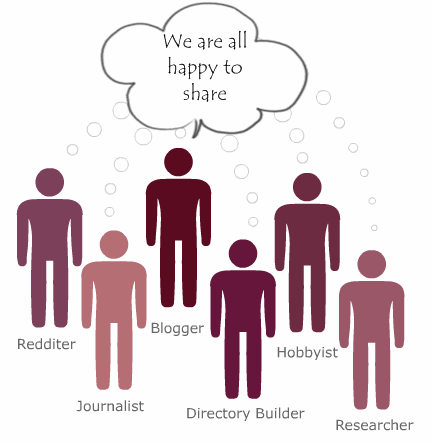
Link Sculpting
Link or page rank sculpting is the process of manipulating how page rank flows through your website. It’s obsolete, as explained here.
Local Rank Tracker
Local Rank Tracker is a feature that allows you to see how your site is performing in specific locations. Rank positions can vary dramatically for one region to another, or even from a city to another. A Local Rank Tracker gives you the opportunity to see how your site is ranking in different geographical areas.
Link Juice
Link juice is not just really a soda.
Tweet
This is a term used to refer to the value of a link. For example, a dofollow link from CNN to your website would have a LOT of link juice. Also, pages with an excessive amount of links are leaking link juice.
Link Reclamation
Link Reclamation is a link-building strategy where you go to find mentions of your brand or business to see if you can get links from those mentions. It also includes the process where you find links pointing to missing pages on your website so you can redirect them to live pages.
Link Profile
Link profile is considered to be the distribution of the links that are pointing from other sites to a site. The link profile does not include internal sites’ links.
Link Velocity
Link velocity – represents the growth trend of a sites’ link profile. Link Velocity trends can also be natural or unnatural. An unnatural link velocity will have various spikes on various timeframes without generating a natural looking trend.
Link Audit
Do you want to develop a strong digital marketing strategy? Start with a link audit!
Tweet
Link Audit is an in-depth analysis that allows you to closely inspect elements related to the link building strategy, link positioning, unnatural links, link velocity, link authority, competition analysis, etc. A link audit is at help in detecting problems and opportunities for your website but it should also be the first step in developing a strong digital marketing strategy.
Link Quality
Search engines examine each link on the websites and determine their value. The precise algorithms that the search engines use to determine the quality of a link are not known. Yet, in determining the quality of a link page, terms as domain authority, trustworthiness, relevance or popularity are taken into consideration.
Link Farm
Link farm refers to any group of sites where all the pages link to each other. Link farms are usually a form of spamdexing as most of them are generated by automated programs. Link farms created manually are designed to allow websites to exchange links with relevant web pages. These ones are not considered a form of spamming.
Local Search Optimization
Local Search Optimization is the process of optimizing your business website for local search results. This includes optimizing your website itself to help search engines determine your location and building local citations to further confirm your business’s local status.
Local Search Query
Within a Local Search Query, results are displayed as an outcome of a search for a specific location. Search engines allow users to submit geographical constraints on their search query. On a local search query, a user will also include information such as city name, neighborhood, street, postal code, etc. For example, a local search for bookstores will look like this: “Manhattan bookstore”, “Bellevue Avenue bookstore”.
Long Tail Keyword/Head keyword
Long Tail Keywords are types of keyword phrases that come from the right part of the search demand graph. There’s a correlation between the search volume and the number of words. That’s why many people think that a long tail keyword must actually be long. In fact, long tail keywords are keywords that have a very low search volume individually, but a huge one when combined. Head and body keywords only compose about 30% of the traffic on the web. The rest are Long Tail Keywords. They are more specific than the usual keywords and are used when the website wants to refine search terms to the website or when the searcher is looking for something very specific. They are also used as an SEO strategy as they are less popular and therefore, less competition. For example, “most effective cold and flue medicine” is a long tail keyword, as it average about 10 searches each month. Head term keywords, on the other side, are more frequently searched. In our example, the head keyword would be “flu medicine”, with about 22000 searches. The correlation between search volume and phrase length is pretty visible in this example. However, if your name is not Donald Trump or Tom Cruise, it could also be a long tail keyword.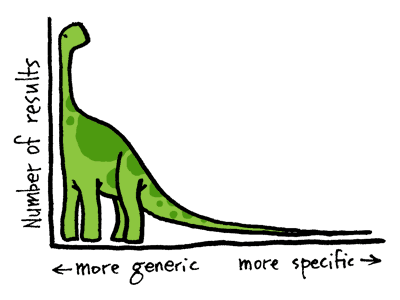
LSI (Latent Semantic Indexing)
LSI is linked to an algorithm called Latent Semantic Analysis which analyses keyword ratios and relationships between different documents. Basically, search engine now don’t just look at the keywords on your page, but also at other relevant keywords on related documents around the web. We also use LSI in our Keyword Tool and Content Assistant to help you improve your content. The tool will recommend keywords you should add to your content in order to make it more relevant for a topic.
Low Quality Links
Low Quality Links are links from sites that Google does not deem as valuable. Links from pages with tons of links on them (like link farms), article networks with low quality content, and link exchanges on “resource” pages are considered low quality.
Manual Penalty
A manual penalty is a ranking penalty unrelated to any of Google’s algorithms. A manual review penalty is applied to a website by a Google employee. If you get a manual penalty, you will receive a warning in Google Search Console. These penalties are usually applied to websites with thin content that aren’t really useful for the users. To protect yourself from these penalties, make sure you add a contact and an about section, so that the Google employees can see you’re a legit business.
Matt Cutts
Matt Cutts is larger than life. He cannot fit in 140 characters.
Tweet
Matt Cutts is a software engineer and the former head of Google’s Webspam team. His work was concentrated on fighting spam and helping webmasters understand how search works. The current head of the Webspam team is John Mueller.
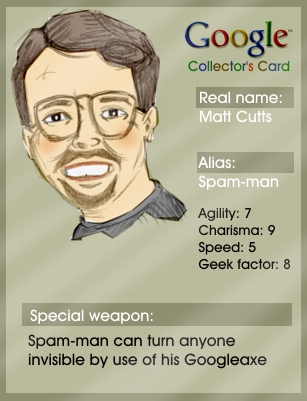
Metadata
Metadata can come in many forms. It represents data that summarize basic information about other data. Using metadata, search engines can find information about a page easier.
Meta Tags
Meta tags are HTML tags on each page that tell search engines what the page is about. The title tag is the most important element to optimize a page for a particular keyword in search. While the meta description doesn’t help with keyword optimization, it is usually shown in search results below the title tag and can help increase click-throughs if written well.
Meta Description
The meta description is a HTML meta tag that displays the description under your page’s title in Google’s search results. Although it doesn’t affect SEO directly, it can have a big impact on CTR. Google doesn’t always display the exact description you want. Sometimes, it just selects chunks of relevant text from your website.

Meta Keywords
Meta Keywords used to specify what keywords a website should be ranked for. Because it was heavily abused, Google declared them obsolete in 2009.
Minifying HTML CSS JS
Web code and files such as HTML, CSS and Javascript can be minified in order to make them smaller in size. This way, they will be downloaded faster and the website will load faster. See Compression.
Mobile Friendly
A mobile friendly website should display accordingly on a mobile device. If it displays the same as on a desktop device, then it’s not mobile friendly. Browsing a desktop version on a small device can be difficult, as you have to zoom and swipe a lot. There are two types of mobile friendly sites: the first is the sepparate mobile version, and the second is the responsive version, that adjusts its width according to the screen size. Since more than 50% of the searches on the internet are made on mobile devices, Google announced in 2015 that sites that are not mobile friendly will get a penalty. This update was also called Mobilegeddon.
Mobile First Indexing
Since most people browse the internet using their mobile devices, Google announced in late 2016 that they will use the mobile versions of the websites to evaluate their relevance for the user. This could cause problems in case the mobile version doesn’t show the entire content of the site. In this case, a responsive version would be better, as the content will remain mostly the same.
MOZrank
MOZrank is a popular score in the SEO industry and it is Moz’s authority score based on the number and quality of incoming links.
Nameserver (DNS)
A nameserver (Domain Name System) simply connects a server’s IP to a more friendly name. This way, you won’t have to memorize an IP when trying to connect to a server.
Natural Language Processing
Computers understand human language through a process called natural language processing. It involves linguistics, artificial intelligence and computer science. Google uses Natural language processing to determine what pages are more relevant to different search queries. It also uses it in voice search, translations and spam detection.
https://www.youtube.com/watch?time_continue=9&v=jubBtD-C9rw
Natural Links
Natural links are a type of backlinks that Google prefers. They are harder to get and are a direct results of your content and marketing efforts. However, unlike unnatural links, they will provide long term SEO benefits.
Natural Search Results
Natural search results, also known as “organic search” refers to that search where the results are returned based on a natural indexing, due to the search engine’s evaluation algorithms and not based on a paid ad.
Negative SEO
Negative SEO is the process of using black hat SEO tactics in order to get someone else penalized by Google. It’s usually done by unethical people to their competitors. Since they can’t outrank the competition fairly using the Google guidelines, they will try to pull the competition down instead.
Niche Site
A niche site is a website build specifically for a single niche/subject. It’s usually small in size (10-20 pages) and offers information on a single topic. In order to have a sustainable business, more than one niche site must be created. These sites are monetized through affiliate sales or Google Adsense.
Noindex
Noindex is a command that tells search engine robots not to index a certain page so that it cannot be found in SERP. Noindex can be used on pages that one wishes to keep private, employee only pages or on webpages that are very transitory.
Not Provided
Not provided. A term you should definitely know about in SEO industry
Tweet
In October 2013, Google made an important change by stopping providing keywords for search traffic. That means that when a search is made on a secure Google webpage, the search term would no longer be passed on the destination website but will be grouped in Google Analytics under the keyword “not provided”.
Off-Site Optimization (OffPage SEO)
Off Page optimization refers to Google ranking factors and signals that are outside of your direct control (not on your website). The most popular offsite optimization technique is link building. Some other types are reviews, social media and citations.
On-Site Optimization (OnPage SEO)
On-site optimization is configuring your website to be discovered by search engines and indexed according to the keywords you are targeting. This includes optimizing meta tags (title, description, etc.) for keywords and optimizing content on each page to support the keywords a page is optimized for.
Organic Links
Organic links are simply natural links. Ones that you don’t have to request, purchase, or otherwise place yourself. They are the ones given freely by other website owners based on the merit of your content. These are the most sought-after links, and the reason why link baiting exists.
Organic Search Results
Organic search results are the websites that show in Google that are ranked by Google Bot’s ranking algorithm. They display under the paid ads results, but are usually the most clicked links anyway. To get ranked higher in the organic search results, you have to optimize your website for search engines (SEO).

Organic Traffic
Organic traffic is the web traffic that gets to your website through the organic search results.
Outbound Link
An outbound link is a hyperlink that points from your website to any other website other than your own. It’s also known as an external link.
Pagerank
Google pagerank is a metric used by the search engine in its algorithm to rank web pages. Contrary to common popular belief, Pagerank is not obsolete.
Page Views
Page views is a metric that measures how many pages a user visits in a single session on your website.
Paid Links
A paid link is a backlink that has been purchased through a service or directly from a website owner. Google advises that these links should include the nofollow attribute to specify that they are sponsored and that PageRank should not flow. Not following these guidelines can result in Google penalties.
Pay Per Click (PPC)
PPC is the acronym for “Pay per Click” and is an online advertising technique in which an advertiser pays the website owner when the ad is clicked. Adwords is maybe the most known PPC advertising platform.
Pay Per Action (PPA)
PPA is the acronym for “Pay per Action” and is an internet advertising technique very similar to PPC with the mention that the pay is done only when clicks result in conversions.
Paid Search
Usually refers to pay per click search marketing through Google AdWords.
PageRank
Judge me by my PageRank, do you?
Tweet
PageRank is the Google authority score given to pages on the internet. This score is based on the number and quality of incoming links a website has. PageRank ranges from 0 (lowest authority) to 10 (highest authority). Only sites like Google itself, Twitter, etc. have PageRank 9 or 10. Average sites with strong link profiles usually fall between PR 3 to 6.
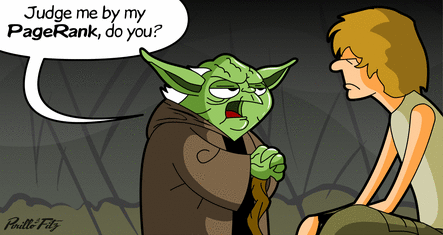
Persona
Persona refers to fictional character whose purpose is to give a sense of empathy for your users. Persona is generating information about your target’s needs and gives you insights about the reasons visitors are on your site. Personas are working like information and knowledge seekers.
Personalization
A search engine’s attempt to bring more personalized results to searchers based on their social networking connections. Google bases personalization on a user’s connections on Google+ and location, and Bing bases personalization on a user’s connections on Facebook and location.
PHP
PHP is the main programming language used for developing websites and web applications.
Private Blog Network (PBN)
RankBrain
Rank Brain is a Google ranking algorithm which uses Artificial Intelligence to determine what websites are the best for the user. It’s considered to be one of the top 3 most important ranking factors, along with backlinks and content quality. RankBrain’s algorithm versions are tested offline before going live.
Ranking Factor
Ranking Factor represent the factors that search engines use in order to rank webpages. For instance, Google uses at least 200 of these factors in its algorithm, such as trustworthiness, domain length, social signals, keyword density, etc. Ranking factors differentiate better positioned websites from pages placed beneath in search results.
Rank Tracking
Rank Tracking is a tool that gives you the possibility to investigate search engine rankings by pages and keywords. Tracking your ranks daily or weekly would give you insight both on your site’s traffic and your competitors’ traffic.
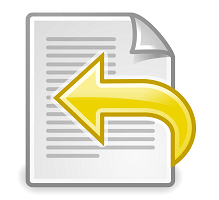
Redirection
A redirection happens when someone accesses a link/URL and immediately lands on another. It’s the result of the HTTP status code 301.
Referring Domain
The number of referring domains is more important than the number of backlinks.
Tweet
Referring Domain, also know as “ref domain”, represents the domain that people “came from” when visiting your site. It is basically the domain from which an inbound link is pointing to a certain page. If, for instance, you are looking in Google for a part of your website and Google returns your site in the search list, when you access your site from that list, the referring domain will be Google.com. If people are talking about your site on forums and someone links to your site from that forum, then the forum will be the referring domain. The number of referring domains is more important than the number of backlinks.
Reciprocal Link
Trading your wife 4 links doesn’t mean you’re doing reciprocal linking.
Tweet
Reciprocal link refers to an agreement between two site owners to provide mutual link between their websites. Reciprocal link purpose is to increase traffic for both sites but also to show a partnership between the two or to provide a quick access to a related website.
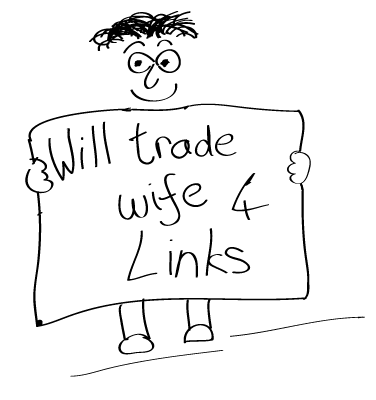
Relevancy
Relevancy usually applies to content, but can also be applied to anchors and keywords. Google prefers backlinks that are coming from relevant pages. If you have a sewing website, links from automobile forums might not be very helpful. However, adjacent topics can easily be found. In our example, those links might be helpful if you’re posting them in a custom car upholstery thread. If the links are surrounded by relevant content, they will be more valuable.
Responsive Design
A website with a responsive design (as opposed to a full mobile version) will adjust its width according to the device’s screen size. Responsive design is based on CSS. The main advantage of a a responsive design is that both the mobile and desktop versions will work on the same URL (no m.site.com version). A big issue with responsive websites are the images. Many designers/developers forget to resize the images accordingly on smaller widths. If images are made smaller through CSS only, the full size image will be downloaded anyway. This slows the website down drastically on mobile devices. To get the right sizes images on the right widths, one can use the srcset image tag attribute.
Return On Investment (ROI)
The profit you make from an invested amount of money is called return on investment. If you invest $100 and make $150, your return on investment is 50%. Compared to direct PPC advertising, SEO ROI is a little big harder to figure out, so it requires a very good monitoring system to be set up.
Robots.txt
Robots.txt , also known as “Robot Exclusion Standard” or “robots.txt protocol”, refers to a standard text file that instruct search engine robots how to crawl and index webpages. For instance, through robot.txt you can instruct a search engine not to crawl and index certain files or directories within your site.
RSS Feed (Rich Site Summary)
The Rich Site Summary notifies you of new content on your favorite websites. Instead of you having to check what’s new on each site, the sites RSS can notify you when something new has been posted. It’s like Netflix vs. the old video store.
Search Algorithm
Most likely referring to Google, the Search Algorithm is the system that determines what sites rank for particular keywords. If you want to get a general idea as to what Google algorithms look for, you can refer to Google’s own How Search Works page.
SEM
SEM – stands for “Search engine marketing” and describes the paid search activities whose purpose is to increase webpages’ visibility in SERPs. SEM is a form of internet marketing that often uses SEO techniques for obtaining high rankings in SERPs.
SERP
SERP- is the acronym for Search Engine Ranking Page and refers to the list of results returned by a search engine in response to a keyword query.
SERP Volatility
SERP Volatility stands for ranking fluctuations. Variation in the algorithmical SERP may occur due to changes in the content of a ranking page, the number of inbound links pointing to that page, the competitiveness of a given keyword or niche, etc. This fluctuations may appear even daily or hourly.
Search Engine
A search engine is a software/program that identifies items in a database. When an item corresponds to a search query, it gets pulled and shown as a search result. Google is the biggest known search engine.
Search Query
Search Query refers to a request that a user makes using a search engine. Every time an internet user “searches” for something on a search engine and presses “enter”, a search query is made. Every search query adds data to the search engine and the results generated become more accurate.
Shared Hosting
As opposed to a dedicated hosting package, a shared server hosts multiple website owners on the same hardware and IP. This can be dangerous, as if one website spams or gets blacklisted, the penalty will be shared through the IP. If you’re on a shared hosting package, it’s a good idea to purchase a dedicated IP address.
Sitemap
An XML Site Map is a web file that lists and structures all the URLs of a specific website. Search Engines use XML Sitemaps to easily identify new pages on websites. It’s especially helpful if your site is brand new, and search engines don’t crawl it very often.
Site Submission
A site can be submitted for indexing to search engines. Google used to have a page where you could submit your URL, but it’s deprecated. To submit new URLs now, you have to connect your site with the Google Search Console and access Crawl > Fetch as Google > Fetch and render. Submitting new content as soon as possible is essential, as content can be stolen from your website by content scrapers. Bing still has a simple submit page, but can only insert the Homepage.
Snake Oil
Snake oil is usually a term assigned to those called “salesmen” that offer webmasters guarantees to appear in the top ranking for a certain keyword. They usually try to convince the site owner that their site is not well optimized and promise groundless high ranking for unreasonably amount of money.
Sockpuppet
In SEO, sockpuppet has nothing to do with The Muppet Show.
Tweet
Sockpuppet refers to an online identity created with the purpose of hiding a real identity or assuming multiple user profiles. The sock puppet usually poses as an independent third-party that defends or supports a person or an organization.

Social Bookmarking
Social bookmarking is a link building strategy where you bookmark a webpage on a social site, such as Delicious, StumbleUpon, Diigo, and similar networks. These bookmarks are usually listed under a profile that is visible to the public. Many of these networks will count the number of bookmarks/votes for a webpage and potentially move it to the homepage if it becomes popular within in a short period of time.
Social Media Marketing
Social Media Marketing includes all the marketing/promotion methods that imply social media platforms such as Facebook, Twitter, Instagram or Pinterest.
Social Media Poisoning
SMP is not just PMS being read backwards.
Tweet
Social media poisoning is a black hat technique that refers to the practice of generating spam content on behalf of a competitor. SMP’s purpose is to put a negative light on a certain brand, making it look like a spammer on social media channels, forums, blogs, etc.
Spam Ad Page
Spam is more than Matt Cutt’s breakfast.
Tweet
Spam ad page refers to a page with advertising purpose in which the content is generated automatically by a machine. This kind of pages don’t add value for the viewers, other than promoting Ads.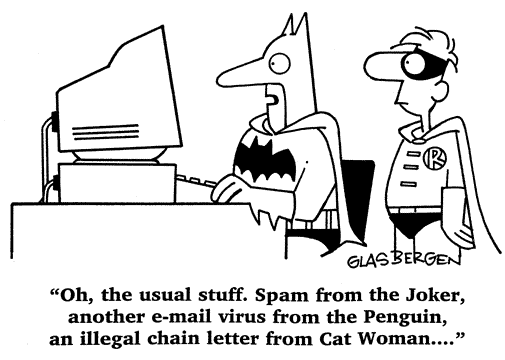
Spambot
A spambot represents an automated program which assists the sending of spam. Spambots can harvest email addresses, on chat rooms or web forms.
Spider
To read about search engine spiders, check the crawler section.
Spider Trap
Spider trap refers to a set of links that are used to cause a web crawler to create an infinite number of pages which don’t exist on the site or cause a poorly constructed crawler to crash. Spider trap may be used intentionally or unintentionally and are created to catch the spambots.
Social Bookmarking
Social bookmarking is a link-building strategy where you bookmark a webpage on social sites such as Delicious, StumbleUpon and similar networks. These bookmarks are usually listed under a profile that is visible to the public. Many of these networks will count the number of bookmarks/votes for a webpage and potentially move it to the homepage if it becomes popular within in a short period of time.
SSL
Secure Sockets Layer is the standard security technology for establishing secure connections between servers and browsers. An SSL connection’s information is encrypted, which means that even if a man in the middle were to steal the information package, they could not read it without the decryption key. It’s very useful (mandatory these days) when doing credit card purchases.
Static URL
On a static URL webpage, the content remains the same. The static URL is like a unique identifier for a unique webpage. For more information, see Dynamic URLs.
Supplemental Index
Supplemental Index refers to Google’s secondary database containing pages considered to have less importance. The importance of a page is measured by the number of links pointing to it. If, according to Google’s algorithm, a page is depreciated, it will not pass to the target page. It will appear on a supplemental page that will rank in search results only if there are not enough pages in the main index. Supplemental results are rarely rank and, thereby, they don’t pull much weight in Google.
Topical Authority
Topical authority refers to the expertise of a website on an entire topic. Instead of targeting a bunch of keywords, think of covering topics that relate to your main industry. For example, if you have a marketing blog, you could talk about SEO, PPC, Content and many other related topics. Topical authority has been linked to better rankings overall.
Traffic Rank
Traffic Rank is a measure that allows to see the popularity of a website and how a webpage is ranking in comparison to other sites. Traffic rank is based on traffic statistics and is calculated using a combination of the estimated daily unique visitors and the estimated number of pageviews.
Title Tag
Title Tag is one of the most important elements in SEO and refers to the main text that describes an online document. The title tag is supposed to give information about the whole page in a few words. Thereby, it is very important to get the title tag right in order to have good search engine results. Title tags can appear in browsers, in search engine results pages and in external websites.
Trackback
Trackback helps bloggers keep track of who is linking to their articles. Can be seen as a way for bloggers to communicate between their web-blogs, a kind of “link notification”.
Trust Flow
TrustFlow is a metric from Majestic SEO that measures how trustworthy a website is.
Trust Rank
Trustrank is a semi-automatic link analysis technique that helps separate spammy webpages from good ones.
Universal Results
The first sample for Google universal search was made in 2001 for Britney Spears.
Tweet
Universal Results represents the lists of results generated by Google Universal Search system, which integrate a vast amount of information available (images, text, video, etc.) into one set of search results. For example, if you search for “Michael Jackson”, Google will return images of him blended with videos or biographical information, all in the main webpage result.
Unnatural Links
Unnatural links are like unnatural food. Looks good but has incredibly bad long-term consequences.
Tweet
Links deemed as unnatural are those that are created with the sole purpose to influence Google’s ranking and are against the Google Webmaster Guidelines.
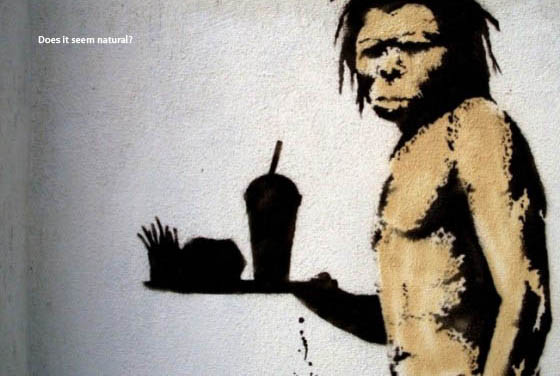
Unnatural Link Profile
A site may have an unnatural link profile if the collection of unnatural links that are pointing to the site is very high. Sites that have an unnatural link profile have a high risk of being penalized by Google or other search engines.
URL (Uniform Resource Locator)
A URL is the address of a web page. It’s what you type into your Browser to access a website. http://cognitiveseo.com is a URL.
User Generated Content
The term speaks for itself. Forums have user generated content. This kind of content is really useful. It’s unique, and you don’t have to put much effort into creating it. Medium is built with user generated content. This concept applies to games as well. Many games have their own editors in which players can create their own maps and scenes. One of the most popular games in the world, Dota, was created in the Warcraft 3 Map Editor.
User Interface/User Experience (UI/UX)
The user interface is the front-end section of an application or website. It’s what the user interacts with in order to use the application. User experience refers to how easy the application is to use. For example, a low contrast between the text color and its background might result in a bad user experience.
Viral Marketing
Viral Marketing is the act of creating content that gets popular very fast. The terminology comes from viruses, that also spread very fast. It’s not easy to make a viral content, but once you get the hang of it, you can profit a lot. The easiest way of making viral content is through video.
https://www.youtube.com/watch?v=0zIbM7jSJrg
Vlog
A vlog is just like a blog but with videos instead of articles. The most popular vlogging platform is YouTube.
Virtual Private Network (VPN)
A virtual private network adds a layer of security to your connection. It’s usually used to encrypt data and hide location. It’s useful as you can protect yourself from cybernetic attacks.
Virtual Private Server (VPS)
A virtual private server is a remote computer that you can access from your home or office and run operating systems and applications on it. It’s useful if you want to run tools that take time to complete tasks, without overwhelming your PC.
Web Directories
Web Directories are used as an easy source of links for any website. Some well-known quality directory link sources include DMOZ, Yahoo, and Best of the Web. There are many others and some easy ways to spot whether a directory is a good fit for your business, or not.
White Hat SEO
White Hat SEO refers to search engine optimization techniques recommended by Google, such as clear linking structures and using descriptive titles.
Whois Privacy
Whois Privacy is hiding the name and contact details of a web domain owner. Google considers Whois Privacy a way of “having to hide something”. For example, Private Blog Network owners might want to hide their names so that their networks won’t be found.
Are there any other terms you would like to see added to this SEO glossary? Please share them with us in the comments section!

 Site Explorer
Site Explorer Keyword tool
Keyword tool Google Algorithm Changes
Google Algorithm Changes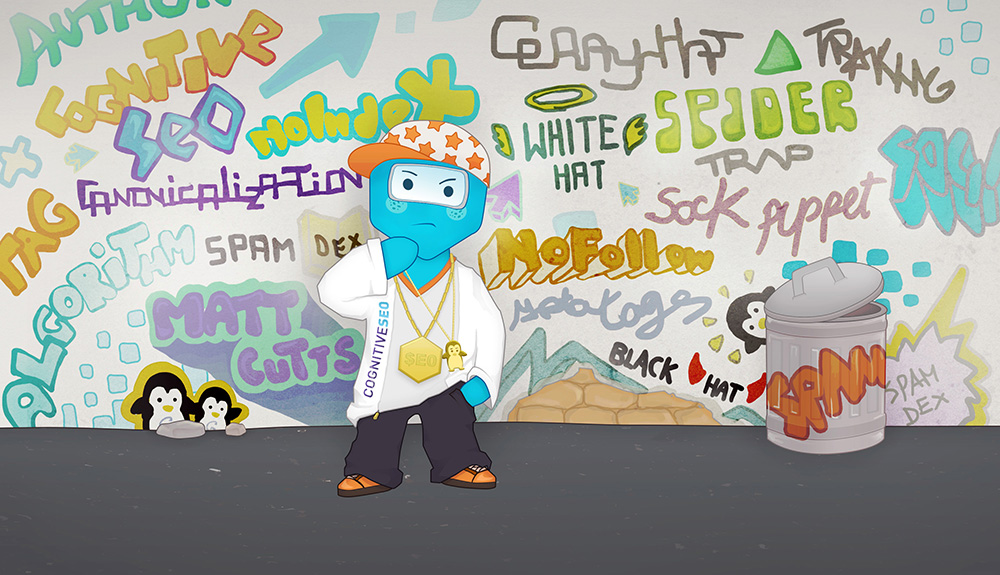


This is my first visit on your website and I really found some amazing information here.looking forward to gain more knowledge.thanks for sharing !!
many terms in the seo world that I was not aware about. Very short and concise glossary.
Cheers
Nice Article, as a fresher I was not knowing many concepts in Digital Marketing especially in the area of SEO, by this above article I almost learned 90% of New terms and its uses. Thanks, CognitiveSEO really appreciated your effort.
Very nice blog! I have seen and read this blog about the SEO terms glossary. This is really awesome. I like it a lot. Thank you and keep posting this type of blog.
Useful!